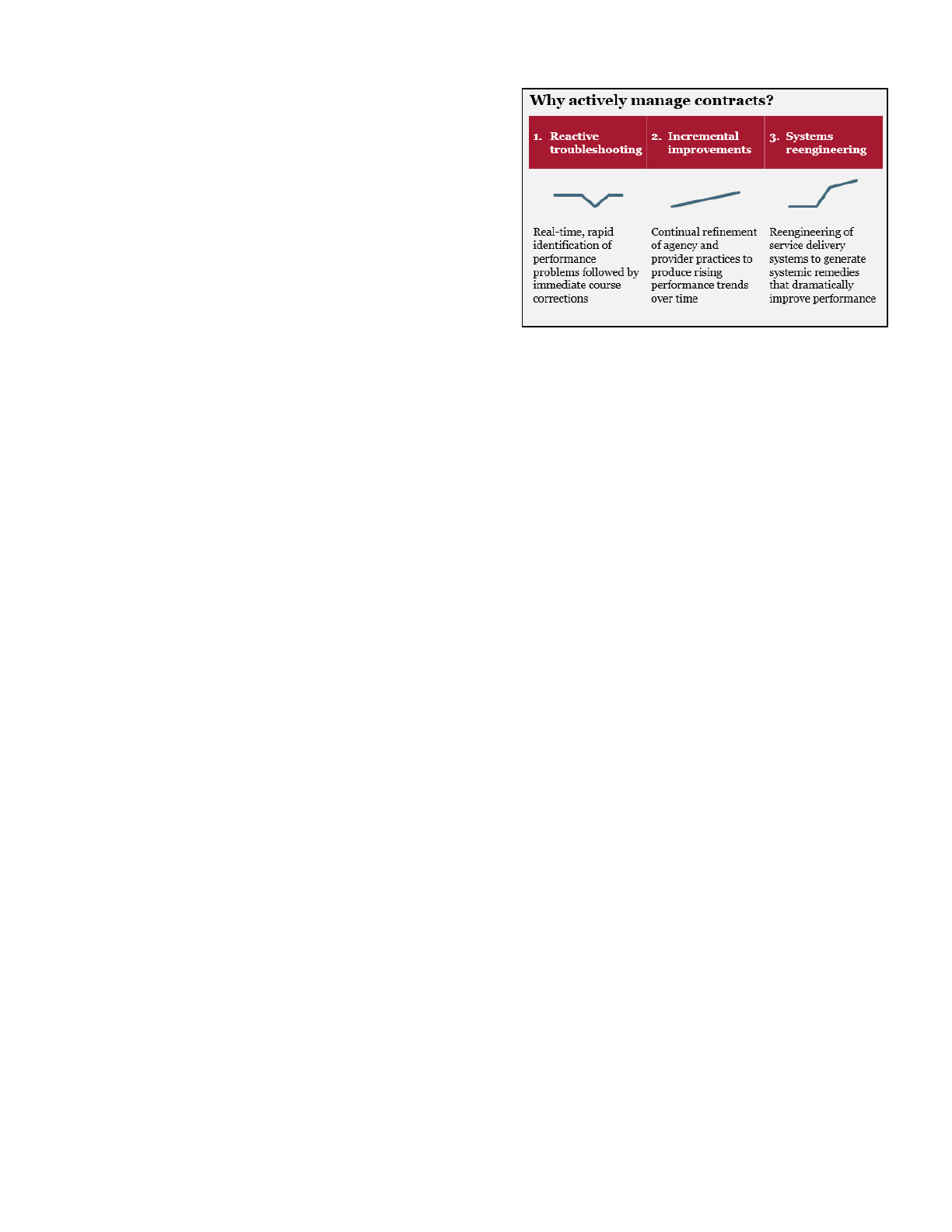
Active Contract Management: How Governments Can
Collaborate More Effectively with Social Service
Providers to Achieve Better Results
1
I. Introduction
Many critical functions of government social service
agencies involve contracting with private service
providers. Increasing the effectiveness of
procurements is therefore essential to improving
governments’ ability to deliver social services. Often
government agencies assume that their role is
complete once a contract is signed and shift to a
narrow focus on processing invoices and enforcing
compliance. However, some of the most important
work for government comes during the course of the
contract, when real-time improvements to service
delivery can drive better outcomes for the people
being served. Agencies should use procurement and
contracting to establish the foundation for an
ongoing collaboration with contracted service
providers to strategically improve performance.
Active contract management (ACM) is a set of
strategies developed by the Harvard Kennedy School
Government Performance Lab (GPL) in partnership
with government clients that apply high-frequency
use of data and purposeful management of agency-
service provider interactions to improve outcomes
from contracted services. We have seen these
strategies adopted by agencies responsible for child
welfare, workforce development, prisoner re-entry,
developmental disabilities, and addiction treatment.
Like PerformanceStat, ACM consists of high-
frequency, data-informed meetings designed to
produce action that improves performance. Where
PerformanceStat is often implemented in order to
improve core government functions, ACM focuses on
collaborations between government agencies and
social service providers to improve contracted
services. ACM empowers leaders to detect and
rapidly respond to problems, make consistent
improvements to performance, and identify
opportunities for reengineering service delivery
systems.
This policy brief describes the problems that ACM
aims to solve, discusses the benefits of using these
strategies, and outlines elements of effective ACM
systems. Examples in this brief draw primarily on
the GPL’s engagements piloting ACM strategies with
state and local governments across the country.
While this brief is focused on how ACM can drive
social outcomes, we have seen these same strategies
improve results of other government contracts,
including for waste collection and road construction.
II. How typical government contract
management practices fall short
Typical contract management practices fall short in
three ways: 1) government agencies do not
purposefully attempt to improve service provision,
2) agencies fail to collect and use data to improve the
delivery of contracted services, and 3) agencies fail
to collaborate effectively with providers to improve
outcomes.
Piloting Active Contract Management
The GPL has helped more than a dozen
government agencies implement ACM strategies
as part of its technical assistance, including:
In New York, the GPL assisted the state in a
Pay for Success (PFS) project that provided
job training and reentry support services for
ex-offenders leaving state prison with the
goal of reducing recidivism.
In Seattle, the GPL collaborated with the
city’s Human Services Department (HSD) to
reorient homelessness service contracts to
focus on helping clients achieve stable
housing.
In Rhode Island, the GPL helped the
Department of Children, Youth, and Families
(DCYF) reprocure and better manage
services offered to children and families as
part of an agency-wide turnaround effort.
In Illinois, the GPL worked with the state’s
Department of Children and Family Services
(DCFS), the Department of Juvenile Justice
(IDJJ), and local probation departments to
expand wraparound services for justice-
involved foster youth.

2
1. Lack of purposeful attempts by
government agencies to improve
outcomes of contracted services
Governments often lack strategies for systematically
improving the results that contracted services
achieve for clients. In our work, we have observed a
homelessness services agency that monitors the
number of showers provided, without tracking the
percentage of homeless families housed; a
behavioral health agency that lacks information on
how service providers delivering the same outpatient
therapies perform relative to one another; and a
child welfare agency that provides annual funding to
community providers without checking to see how
client needs may have shifted.
In these and other governments, contracting is
treated as a back-office function, handed off to
administrative units focused on compliance and
invoicing, which are disconnected from the
programmatic objectives of the agency. Staff track
billing accuracy and volume metrics in isolation
from any performance management activities.
This compliance focus is particularly costly in the
context of overly prescriptive contracts, in which
time-consuming change orders are needed in order
to make even minor operational adjustments. What
quality assurance activities exist occur at the case
rather than systems level, and often focus on
determining whether providers are meeting
licensing requirements and basic standards of care.
Incidents of poor performance are addressed in
isolation, and necessary improvements are specified
only in one-off provider-specific corrective action
plans. For example, in one agency responsible for
providing vocational training to TANF recipients,
providers are regularly relicensed without any
systematic efforts to address the state’s near-bottom
of the nation ranking on employment outcomes for
this population.
Rarely do agencies look across programs, providers,
and internal operations to measure the actual results
of service delivery or identify opportunities for the
entire system to work better.
2. Failure to collect and use meaningful
data to improve service delivery
For many government programs, data is not used
effectively to monitor, inform, or improve service
delivery—the right data is not collected or shared
between governments and providers, and data that is
collected is not used to drive action.
Lack of data usage often begins with the limited
availability of actionable operational data. Often
governments aren’t collecting the right data from
social service providers. Providers delivering similar
programs often report on different data measures.
Incomplete, inconsistent, or late data reporting is
common when data collection is not prioritized.
Frequently, government administrative data is not
shared with providers in a timely manner, so that
even the most data-driven providers have trouble
accessing information needed to adjust operations.
Similarly, data on provider operations is often
opaque to government, making it difficult for
government to track key operational indicators. This
fragmentation hinders attempts to calculate
important metrics that require both government and
service providers to share data with each other.
In one child welfare agency, providers of
maltreatment prevention services were never given
access to information about the abuse and neglect
outcomes of their clients after their care had ended,
substantially impairing their ability to assess
program success.
Even when the right data is collected, government
officials often fail to use it in a way that can drive
management decisions. Contract management
offices generally have limited data and analysis
capacity. Without available staff that can review data
and ask questions to drive operational or practice
reforms, provider data is used only retrospectively to
validate contract compliance, rather than to make
real-time improvements. The data is not used to
identify high performing providers or best practices
or to inform future policy decisions. When data is
published, it is often in aggregate format and offered
without interpretation, making it difficult to discern
the connection between specific practices and
results.
For example, we observed one human services
agency that annually published a report showing
how client outcomes varied for different types of
services received by agency clients. However, raw
data about provider-specific results was not shared
with the agency’s frontline staff so that referrals
could be adjusted, nor used by the agency’s contracts
units to inform award decisions in upcoming
procurements.
The failure to collect the right data and use it is
incredibly frustrating to both providers and agency
staff – who are spending so much of their time
reporting and tabulating data that is not being used
effectively.

3
3. Lack of productive collaboration with
service providers
Often, government does not regularly engage with
service providers to assess how service delivery is
going or what actions could improve it. Once a
contract is negotiated and signed, contact between
the agency and providers is focused on compliance
with contract terms, invoicing, or responding to
emergencies. Contract monitors may conduct annual
site visits to ensure adherence to contractual
guidelines or licensing requirements, but these visits
rarely involve conversations about how performance
can be improved.
Performance problems are often addressed
punitively resulting in penalties without shared
learning. With relationships between agencies and
providers often adversarial in nature, few
opportunities exist to build the trust necessary for
jointly driving reforms.
Additionally, providers rarely receive information
comparing their performance to that of their peers,
which limits opportunities to identify and replicate
best practices.
III. Active contract management
Active contract management consists of high-
frequency data-informed collaboration between
government agencies and service providers that is
focused on outcomes. The GPL has been developing
and piloting ACM in our work with state and local
governments across the U.S. In each of these
jurisdictions, the government found that
implementing this new approach to managing
contracts allowed both the government and
providers to solve problems and make sustained
improvements in service delivery.
We observe three primary benefits when agencies
actively manage the performance of their contracted
providers:
Reactive troubleshooting: Real-time, rapid
identification of performance problems allows
governments and providers to make immediate
course corrections. In the New York State
criminal justice project, the state and service
provider identified an issue with low enrollment
numbers at the project’s outset, and immediately
adjusted referral processes to address this.
Incremental improvements: Persistent
attention on critical performance issues can
facilitate ongoing improvements in results. This
work often involves agency leaders reviewing
data on whether programs are doing
better this month than last month (and this year
compared to last), and holding agency staff
accountable for continually refining their
processes and those of their contractors to
produce rising performance trends over time. In
Rhode Island, persistent attention to conducting
clinical child assessments resulted in steady
improvements in completion rates, which
enabled services to be better tailored to client
needs.
Systems reengineering: Often, dramatic
performance improvements can be achieved by
revising protocols for matching clients to
services, partnering with other government
agencies to overcome care coordination siloes, or
shifting resources to the most effective programs
and providers. In Illinois, DCFS recognized a
multi-week lag between reporting of
circumstances that present risks to youth in
state care and notification to the agency.
Handwritten reports were faxed to a central
office, requiring manual transcription into a
state computer database. As of February 2017,
the agency was in the process of automating this
system, which should decrease the time between
the occurrence of incidents and potential
referrals to providers for additional services
from several weeks to less than a day.
These benefits are made possible by three common
components of ACM strategies:
1. High-frequency reviews of real-time
performance data
Frequently reviewing real-time, operationally
meaningful performance data enables agencies and
providers to rapidly identify and address service
delivery problems before they become ingrained or
unfixable. It also creates feedback loops for
providers and program staff to assess and refine
changes to service delivery.

4
In the New York State criminal justice project,
project partners monitor data on a biweekly basis to
determine the percentage of individuals being
released from prison attending the first day of job
training services. When this percentage falls below
targets, immediate course corrections are designed
and implemented.
Seattle’s HSD is also using performance data to
collaborate with providers to monitor progress,
detect problems, and resolve issues in real time.
Data are reviewed monthly across six key
homelessness metrics (including permanent
housing, housing stability, and returns to
homelessness)
1
that are used to drive towards more
effective service delivery.
2. Regular, collaborative meetings between
service providers and agencies
Regular, collaborative meetings enable service
providers and agencies to swiftly troubleshoot
problems, solve specific operational challenges, and
identify opportunities for broader systems
transformation. These meetings often feature
substantial data reporting and analysis, case reviews,
and the sharing of best practices.
A typical active contract management meeting has
three agenda items: 1) follow up on action items
previously identified and a summary of lessons
learned to-date, 2) discussion of progress against
high-priority performance measures and joint
troubleshooting of any problems that may have
emerged, and 3) in-depth examination of a topic
critical to success but not regularly reported or
reviewed.
The Seattle HSD is establishing three types of
meetings as part of its ACM strategy:
Monthly data sharing and contract check-ins
between HSD and service providers, where
progress reports that measure outcomes on six
key homeless metrics for each provider are
reviewed in order to troubleshoot program-
specific problems.
Quarterly internal HSD meetings, in which HSD
staff assess system-wide performance on key
outcomes and indicator metrics to obtain
internal consensus on strategic programmatic,
funding, and policy decisions to improve results.
Quarterly executive meetings between HSD and
service providers, where homeless population
outcomes are reviewed, general trends are
1
For more information, see pages 5-6 of the GPL brief on
the Seattle homelessness services project
identified, and the relative performance of
service providers is used as a learning
opportunity.
In collaborative meetings such as those being held in
Seattle, reviewing data is often only the start of the
conversation. It is important that agencies and
providers use lessons from the data to develop and
implement strategies to improve outcomes.
It is also often useful to convene groups of providers
targeting similar populations to facilitate peer
learning, share effective practices, and resolve
common barriers. Improvements in service delivery
frequently require adjustments by both the referring
agency and the service provider, and can be
replicated across multiple providers offering similar
services.
In Rhode Island, DCYF facilitates monthly ACM
meetings with leadership teams from each of its four
front-end family preservation service providers. Ad
hoc working groups consisting of agency and
provider staff meet more frequently as needed to
address specific performance issues raised in
executive meetings. “This active contract
management experience has provided us with new
clarity on the goals we are trying at achieve,”
observed one provider of child welfare services in
Rhode Island. “This clarity makes it easier for my
staff, and informs how we need to adjust our
program model moving forward.”
3. Forward-looking performance
management roadmaps
Performance management roadmaps help agencies
proactively direct in-depth analytical attention
toward topics and practices that are critical to
success but may not be regularly reported or
reviewed. Roadmaps can be organized as running
calendars of priorities for deeper investigation. Often
additions will be made to follow-up on specific
operational challenges uncovered in progress report
reviews. Without such roadmaps, it is easy for
agencies and providers to inadvertently focus solely
on reactive adjustments or incremental
improvements, missing opportunities for systems re-
engineering.
Some roadmap topics benefit from advanced
quantitative analysis, such as regression-
discontinuity techniques to evaluate referral
decisions. In other circumstances, it may be helpful
to pull and review individual case files to inform
interpretations of aggregate time series data.
Rhode Island’s DCYF has organized ACM according
to a forward-looking 12-month performance

5
improvement roadmap, which is regularly updated.
This roadmap contains the plan of which in-depth
analyses will occur each month at the ACM
meetings. Throughout the course of the first year of
ACM, the agency and providers examined family risk
factors associated with higher service needs,
assessed providers’ strategies for identifying and
matching families to programming, and determined
which service components are most critical for safely
keeping families together, among other topics.
When beginning ACM with a new group of
providers, it is useful for early in-depth topics to
focus on identifying key performance metrics for
regular review and generating benchmarks and
targets.
IV. How can governments maximize the
effectiveness of ACM practices?
Implementing ACM nearly always requires agencies
to restructure internal operations in several ways:
picking the right measures to track, using data to
drive action, creating a culture of partnership to
improve performance, and elevating the status of
contract activities.
Select the right measures to track:
Choosing appropriate measures for regular attention
is a critical first step in transitioning provider
reporting requirements from compliance to
performance. When agencies track activity
measures, they should chose indicators that are
linked to successful service delivery, such as time
from referral to service enrollment, program take-up
and completion rates, and spending per client. For
example, for services designed to stabilize
individuals in crisis, reaching clients within hours of
referral can be the difference between
hospitalization and successful diversion to
outpatient care.
Medium and longer-term outcome metrics, such as
recidivism rates, are critical to track as well. Input
metrics, such as meetings conducted or staff-hours
billed are rarely helpful for assessing provider
performance.
Once measures have been selected for tracking,
agencies and providers should jointly identify
benchmarks against which performance trends can
be contextualized. A combination of historical, peer,
and best-practice targets are helpful in determining
performance goals.
Use data to drive action:
Data should be used to identify the right problems,
creatively craft solutions, and subsequently drive
sustained action. Dashboards, which enable regular
attention to a small set of metrics, are often helpful
but rarely sufficient without active interpretation
and pre-meeting analysis of operational
implications. Generating real understanding
requires a capable analyst to look at data,
contextualize it in relation to program operations,
and ask questions about it to drive a reform.
However, it can also often be as simple as examining
why a performance trend has (or hasn’t) changed
from the previous period, or why one vendor has a
different client mix than another.
Rhode Island DCYF discovered that families who
regularly participated in family preservation services
for at least 3 months were half as likely to experience
subsequent child welfare involvement compared to
those who completed less than 3 months of service.
2
Based upon this insight, providers created a handout
to help convince newly referred families to engage in
services.
Supplementing analysis of aggregate performance
data with in-depth review and discussion of
individual case files is often critical to correctly
interpreting the aggregate trends. Reviewing a small
number of cases from a mix of clients with good and
poor outcomes can often distinguish among
alternate explanations for performance trends and
point the way to the right implementation changes.
In some cases, it can be helpful to have multiple
providers learn from each other based on relative
performance. For example, six providers partnering
with Illinois to expand wraparound services for
justice-involved foster youth review weekly data on
success engaging families in team meetings.
Providers who ranked lower actively seek out those
who ranked best to learn from them on how to
improve their performance. Frontline staff from all
six providers also regularly meet to share best-
practices and brainstorm solutions to barriers to
care.
Create a collaborative performance
management culture:
It is important to develop an active contract
management culture that encourages a collaborative
2
Further analysis suggested that this difference was not
simply the result of better functioning families being more
likely to agree to services.

6
partnership with providers and shared ownership by
government for improving client outcomes.
Thoughtfully considering the frequency, timing,
structure, and attendees of regular meetings to
maximize productivity is critical. The tone set by
agency leaders should be constructive rather than
punitive, as the focus should be on generating
solutions toward the common goal of improving
service delivery. In one jurisdiction, the program
director of a provider participating in ACM reflected
on this, saying, “Our program supervisors appreciate
the chance to do deep dives in collaboration with
agency staff – it’s no longer us versus them.”
Commitment by agency leadership is also critical.
Regular executive attention to provider results
throughout the life of the contract – and not just
when problems arise – demonstrates to providers
that performance improvement is an agency priority.
If major barriers arise, it is helpful to have robust
existing relationships between executives in order to
resolve problems as quickly as possible.
Similarly, agencies should create mechanisms for
frontline staff to immediately elevate provider
performance problems to ACM staff and agency
leadership. For example, one agency is considering
an online tool through which frontline caseworkers
can report to the contracts unit any problems
accessing transportation, clothing, and other
contractually required resources. Data generated
from these reports will help the agency detect
common issues with specific providers, develop
strategies to address these problems, and assess the
success of remedial actions. Agency data and
evaluation units should regularly engage with front
line staff to get their suggestions for which processes
could most benefit from deep dives during active
contact management meetings.
Regularly share government
administrative data with providers:
It is as important for agencies to share government
administrative data back with providers as it is for
providers to consistently report high-quality data to
agencies. Regular sharing of government
information about what happens to clients after they
complete provider services, for example, enables
providers to learn and adjust service delivery
operations.
Some agencies establish joint management
information systems in which the same database is
used by the government for maintaining
administrative records and by providers for tracking
day-to-day client management and service delivery.
In Seattle, HSD and homelessness providers have
access to the same database, enabling each to
generate the same performance reports.
Other agencies chose to share administrative data
with providers by regularly generating reports from
agency datasets; however, if not automated,
sustaining this practice requires ongoing staff
attention. Alternatively, linking a small portion of
payment to one or more outcome measures for
which providers don’t otherwise have access
institutionalizes these data feedback loops for
providers without requiring additional government
capacity.
Elevate the status of procurement and
contract management activities:
Adequately resourcing agencies’ contract
management functions is critical for improving
provider performance. Contract managers must be
perceived both internally and externally as senior
leaders responsible for driving a key part of the
agency’s mission. For example, to oversee its active
contract management practice, Rhode Island’s DCYF
established a Contracts and Compliance unit that
reports to the director’s office.
To fully implement ACM practices, staff will also
need to have time and training to effectively review
performance data, flag problems, and work with
providers to implement any necessary changes. Staff
must be empowered to work across agency units to
access information, breakdown barriers, and
influence change.
Since active contract management is time intensive,
agencies may need to streamline other contract
office work to free up time for performance work.
Seattle’s adoption of active contract management for
homelessness services was paired with a
consolidation of contracts that significantly reduced
invoicing and change orders.
3
Additionally, training current contract managers or
hiring a new type of employee to actively manage
contracts may be necessary for building
organizational capacity. For example, Rhode Island
conducts workshops to teach agency employees how
to use provider data to detect, diagnose, and respond
to unexpected performance trends.
Seattle HSD considered whether it should hire
dedicated staff responsible for the fiscal monitoring
of contracts to allow contract managers to solely
focus on performance improvements or add contract
3
For more information, see page 5 of the GPL brief on the
Seattle homelessness services project

7
managers so that each could handle both fiscal
monitoring and performance for a smaller case load.
Other jurisdictions separate contract compliance and
performance management duties to allow
specialization and to more fully leverage the
technical capabilities of data-fluent staff.
V. Questions on Spreading and Sustaining
Active Contract Management
As we continue to help governments implement
ACM, we are testing solutions to questions about
spreading and sustaining this practice.
How can active contract management be
spread across an entire agency when
resources are unavailable to sustain this
high-intensity approach for every contract?
Agencies will need to prioritize which contracts are
important enough to employ the full set of ACM
techniques. Vendors who are delivering high impact
services or new services, vendors who are at a high-
risk of running into obstacles or have had
historically poor results, and vendors whose
contracts are large in dollar value or in complexity
should be prioritized to receive the most attention.
One way to reach a broader audience with scarce
resources is by using performance improvement
sprints, which focus brief but intensive attention on
a rotating set of contracted providers. Sprints aim to
solve a more limited set of performance issues than
what would otherwise be included in an agency’s
performance improvement roadmap.
Alternatively, a select set of universal performance
metrics could be required across all vendors. One
way to do this is to link a portion of payment for
services to one or more common indicators of
results, such as sustained employment for a certain
period following referral to services. Linking even a
very small amount of payment to results ensures that
data collection will be sustained throughout the
period of the contract.
How can agencies provide necessary
technical assistance to support providers
when performance gaps emerge?
Many contracted service providers, especially those
providing health and human services, lack
sophisticated data, finance, or strategy capabilities of
their own. While ACM can often help these providers
identify opportunities to improve service delivery, it
does not provide the in-depth support necessary for
providers to wholly revamp internal operations.
There are a few options for agencies to support
providers when performance gaps emerge. Some
agencies connect contracted providers with third-
party capacity building resources such as the U.S.
Small Business Administration or local business
associations. Others are exploring how to give
providers access to resources available to state
agencies, such as technical assistance organizations
or Lean process improvement consultants.
While we are unaware of any examples, agencies
might also experiment with joint data and analysis
training for government contract managers and
provider program leaders.
What is the potential role of funders in
requiring reporting around coordinated
outcomes metrics?
Many service providers receive philanthropic
funding in addition to government contracts.
Philanthropic grants typically include reporting
requirements on metrics that are disconnected from
those that government agencies prioritize through
ACM.
Philanthropies have an opportunity to coordinate
with government to require consistent reporting
around coordinated outcomes metrics in a way that
allows government, providers, and philanthropy to
identify successes, pinpoint challenges, and work
together to improve services.
VI. Conclusion
Government too often assumes that responsibility
for achieving outcomes is handed off to providers
once a service is contracted out. To achieve effective
delivery of social services, government must
maintain its share of responsibility for results during
the period of service delivery and be an active
participant in refining systems to improve client
outcomes. ACM offers government a set of strategies
for undertaking these partnerships with providers.
These strategies can be an important part of a
broader results-driven contracting effort to improve
the results achieved with contracted dollars.
4
The Government Performance Lab is grateful for support
from Bloomberg Philanthropies, the Corporation for
National and Community Service Social Innovation
Fund, the Dunham Fund, the Laura and John Arnold
Foundation, the Pritzker Children’s Initiative, and the
Rockefeller Foundation. © Copyright September 2017
Harvard Kennedy School Government Performance Lab.
4
For more on reforming procurement practices, see the
GPL’s policy brief on Results Driven Contracting.
